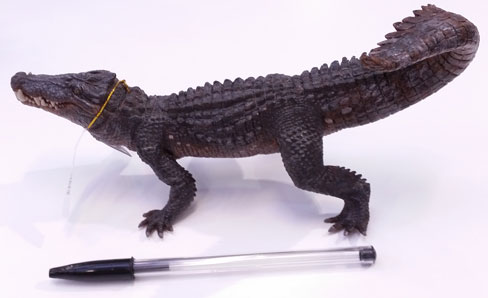Seventy-Million-Year-Old Prehistoric Crocodile
Researchers at McGill University (Montreal) and the University of São Paulo (Brazil) have described a new species of terrestrial crocodile that stalked the Late Cretaceous plains of Brazil. This bizarre, deep-snouted crocodile had fang-like teeth and long legs indicating that this was a crocodile which, unlike its extant cousins was very comfortable out of the water.
To McGill palaeontology professor Hans Larsson, one of his graduate students Felipe Montefeltro and Professor Max Langer of the University of São Paulo, a recently discovered crocodile skull looks a little like the skull of a dog with its deep, broad features and its large teeth. However, to the casual observer this is one creature that you would not like to come across, after all it could probably run quicker than your average person.
Named Pissarrachampsa sera, the fossil was discovered by a municipal worker in 70-million-year-old Cretaceous sediments in a small town in Minas Gerais, Brazil. Sent to check it out by the Society of Palaeontology in Brazil, Langer and Montefeltro realised they had something very special. The three researchers have documented their observations in the July edition of PLoS One (the public library of science).
Pissarrachampsa sera
Familiar with Hans Larsson’s work on crocodiles and dinosaurs, Montefeltro got a study grant from the Brazilian government and brought the fossil to Larsson’s lab at McGill’s Redpath Museum, where they have been studying the head and finding that this remarkable terrestrial crocodile reveals almost as much as it conceals.
Professor Larsson stated:
“Whereas modern-day amphibious crocodiles have low and flat heads, this new find gives us one of the first detailed insights into the head anatomy of this weird group of extinct crocs called Baurusuchia that feature tall, dog-like skulls with enlarged canines, and long-limbed body proportions.”
Their ecology was probably similar to that of wild dogs living today. Given the number and size of their teeth, the researchers believe these carnivorous crocodilians fed on animals about as big as they were, in the 5 metre plus range. So dinosaurs and other reptiles would have been on the menu. Whether these crocs. formed packs like hunting dogs is unknown. They would have used relatively stereoscopic vision to track prey and, rather than scramble like the crocs we see today, they galloped along on elongated limbs.
A sketch by Larsson imagines how this newly discovered species would have appeared in predatory motion. Though the body might seem more dinosaur in shape than today’s crocodile, the fossil head carries the definitive characteristics of crocodiles from that era, including a well-developed secondary palate, socketed teeth, advanced cranial air spaces, roughened bone surfaces, plated armour, and massive attachments for jaw closing muscles.
Recent CT scans are offering more fascinating aspects of the fossil, such as its brain size and shape and hearing abilities. Baurusuchian crocodiles are characterised by a significant number of unique anatomical features such as low tooth counts, tall, thin skulls, forward facing nostrils, and derived jaw-closing muscle attachments. After comparing the new species to other Baurusuchids and their relatives, the researchers noticed large gaps on either side of the fossil’s morphology.
Montefeltro commented:
“We are dealing with an exceptionally divergent lineage of extinct crocodile diversity. There are many fossils that still need to be found to link this crocodile to those who came before and after.”
Montefeltro explained that the name of this new member of the croc family pays homage to the location of the fossil’s discovery. Piçarra is a regional word for sandstone and Champsa is a Latinisation of the Greek word for crocodile. Sera, is Latin for late – which refers to both the circumstances in which the fossil was found, that is, it was almost left behind in a 2008 expedition because of a tight schedule and, the Minas Gerais state flag that quotes Virgil “Libertas Quæ Sera Tamen” meaning “Freedom, Albeit Late.” One thing that is for sure, if these animals were around today, then a any unwary tourist to its Brazilian homeland could very well end up “late and lamented”
Though their importance for Crocodyliform evolution is widely recognised, there are still a lot of questions about the internal relationships of the group not yet studied, but which all three researchers plan to explore. A digital reconstruction of the fossil’s brain cavity is a work in progress and will be presented later this fall at the Society of Vertebrate Palaeontology’s annual meeting.
Recently, Safari introduced a model of Late Cretaceous terrestrial crocodile called Kaprosuchus. To view the Safari model range and dinosaur models: Kaprosuchus and Other Archosaurian Models.
A Model of the Prehistoric Crocodile – Kaprosuchus
Picture credit: Everything Dinosaur
To view the Papo prehistoric model range: Papo Kaprosuchus and Prehistoric Animal Figures.
Reproduced with kind permission: The McGill Reporter who helped Everything Dinosaur compile this news story about a prehistoric crocodile from Brazil.







Leave A Comment